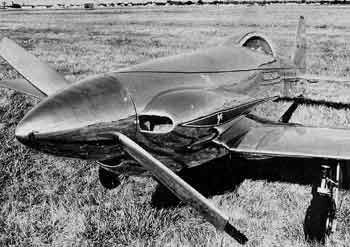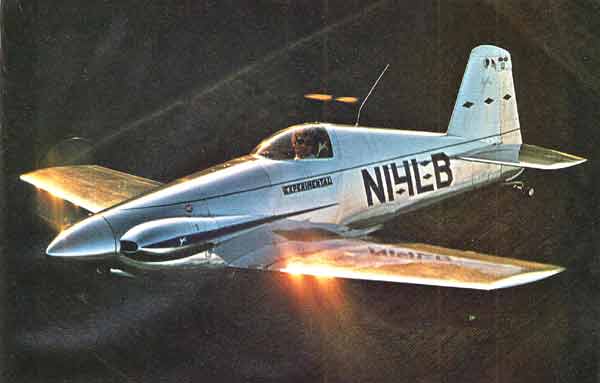
Photos and Text by Budd Davisson
Air Progress, December, 1975
Pirep:
Reflections on a Two-Time Grand Champion

Photos and Text by Budd Davisson
Air Progress, December, 1975
Pirep:
Reflections on a Two-Time Grand Champion
I was feeling anxious as I looked out at those chrome-like wings and down that mirror straight cowling. I wasn't worried much about being able to fly the airplane, but the awful responsibility of actually flying an airplane that's too pretty to face the vagaries of flight at strange hands was getting to me. This craft was the Grand Champion Homebuilt at Oshkosh for two years running. Its lines and metal work were only supposed to appear in artists' renderings. Lloyd "Jim" Butler's retractable gear, folding wing Midget Mustang was something else ... something that nearly defied description. At that point, sitting there in front of that machine-turned panel with the tiny stick in my hand and the Plexiglas bubble doing its best to enclose my boggled mind, I wasn't absolutely certain I had the guts to fly this machine. But, let's be realistic, I wasn't about to turn down the chance either.
My hand moved forward clenching the throttle and the 100-hp Continental responded with more pep than it ever had in a C-150. My visibility over the nose was restricted, and I had to stretch my neck to get the the canopy combing down out of my peripheral vision for a clear view of the edges of the rapidly moving runway. 1 didn't even try to lift the tail. I let it come up when it was ready and then held a tail low position; my feet applying slight pressure on the right rudder to keep from turning left. Then came the fear and apprehension in remembering to reach up and throw the magic switch that made the wheels disappear behind those clam-tight doors in the belly.
 |
 |
Nose down, I got 180 mph indicated and gently sucked the nose up into a loop. Up, up vertical and then, as the nose approached the inverted position, the airplane let me know I'd been heavy handed by unceremoniously doing a half-snap into a right side up position ... I had stalled it. I looked around to see if anybody had seen my foul-up (I could always claim it was an intentional Immelmann), and tried again. The second try was just as embarrassing. Eventually, I found it took hardly any stick pressure to loop. Just pull the nose up and let it find its own way over the top. It knows how much G it wants on the top and it will do it all by itself, with no help or hindrance from the guy at the controls.
Enough. It was time to work, so I got the carb heat and slowed down for a stall. First of all, slowing down isn't easy. It's like trying to get a rifle slug to shed speed. Holding a nose high attitude, I watched the needle wind its way slowly towards the bottom. Finally, at about 60 mph IAS, with almost no buffet at all, the wing said it had had enough and quit flying all at once. It was very much as you'd expect from this type of airplane, a wing dropping, sharp-edged stall, with a very quick recovery. I have a hunch, if you were to cross control very much during a stall, it would probably snap into a spin with little or no wavering.
 |
I bent and twisted, pushed and pulled until I started to feel guilty and began to think about giving the man his airplane back. But, wait, I can't just blithely hum along in this thing without finding out for sure how fast it is. I'd been looking at indicated airspeeds of 160 mph plus all the time that I was in it, but we all know what liars airspeed indicators are. So, up into a 45-degree bank, power off, pulling hard, I screwed my way down to 1000 feet AGL to go looking for some easily identifiable check points. Four times I ran two-way distances, and four times I came up with a speed of 160 mph 2400 rpm. I have to admit I was a little disappointed, although that still works out to about 27 miles per gallon. Bob Bushby the biggest fan and promoter of the Midget Mustang says the usual 100-hp Mustang should cruise at about 190 mph. Butler's airplane doesn't seem to have the proper propeller pitch for best cruising. Also, it's carrying around about 70 pounds of extra weight with the retractable gear and other Butler modifications. In the Pazmany efficiency run, Butler topped out at just about 200 mph, but he must have been winding it a whole lot tighter than I was. Basically, it'll go about as fast as you want to go, depending on how much fuel you want to burn.
Then came landing time and suddenly, I was scared again. I mean, you don't often hurt an airplane unless you hit the ground with it. Downwind, I unlocked the gear, hit the switch and heaved a sigh of relief when I saw the "down and locked" light go on. One worry behind me. With two notches of flap (I still hadn't touched the trim since I first took off), I set up 90 mph and turned base trying to gauge my height. I looked high from the very beginning so I hadn't been carrying any power at all since downwind, but when it came time to turn final, it was obvious I was still high. This all came as a surprise because I expected it to come down much, much faster. I didn't want to embarass myself by having to go around, so I gingerly (I'd forgotten to ask him about them) began to slip. Nothing unusual happened, so I slid as far into a slip as it would go. It ran out of rudder almost immediately and I came down final with one foot on the floor and the nose only slightly to one side. Even flying sideways it had a very, very flat glide angle. It's a clean machine!
 I remembered the ground attitude on takeoff as being extremely flat so I floated down to about five feet and added just a little power to hold the attitude I wanted. As I squeezed the power off, it settled down and took care of the landing all by itself. Because of the direct linkage to the tail wheel (no springs) there's no delay at all to rudder pedal inputs. I wasn't actually stepping on a pedal as much as 1 was pressuring them one way or the other in an attempt to stay on the white line while rolling out. And does it ever roll! It's so clean that it just doesn't want to stop running, even on the ground, and I know for a fact I had no more than 65 mph on touchdown.
I remembered the ground attitude on takeoff as being extremely flat so I floated down to about five feet and added just a little power to hold the attitude I wanted. As I squeezed the power off, it settled down and took care of the landing all by itself. Because of the direct linkage to the tail wheel (no springs) there's no delay at all to rudder pedal inputs. I wasn't actually stepping on a pedal as much as 1 was pressuring them one way or the other in an attempt to stay on the white line while rolling out. And does it ever roll! It's so clean that it just doesn't want to stop running, even on the ground, and I know for a fact I had no more than 65 mph on touchdown.
I feel as if I've started at the top and now have to work my way down. I had never even sat in a Midget Mustang before and now the only one I've banged around in is the champ. I have no idea how representative it is of the breed, but I can't believe it handles a heck of a lot differently. Butler, who has lots of time in both types of the little birds, says the difference is mostly in the way his builds up and maintains speed, which would be expected with the retractable gear.
The original Midget Mustang, as designed by Dave Long for racing, was, and is, a nearly perfect sport airplane. Its all-metal construction has been thoroughly engineered and tested throughout the years. Currently the plans are available from Bob Bushby of Busby Aircraft, Inc., Minooka, Illinois. As an educated guess, there have probably been between 50 and 75 of them built using everything from the original 85-hp Continental it was designed for up to a few super-exotic jobs with better than 200 hp. All of them cruise in the 160-190 mph range. The nice thing about Midget Mustangs is that there are about a trillion of them being built and you can usually find somebody who's got one partly finished you can look at. As metal airplane's go, it's neither easy nor hard to build (no airplane is easy) and aluminum hasn't inflated any more than steel tubing and fabric ... they're all out of sight now.
There have been at least two other RG Mustangs built besides Butler's that I know of, but they were all done by guys like Butler ... near-pros. If I were building one, I'd probably opt for the old fashioned leaf spring gear, simply because I wouldn't want to get mixed up in designing a gear and the wing modifications needed to house it. One thing is certain though, it sure is a pretty airplane with the wheels tucked up.
It's almost axiomatic that when the EAA or anybody else declares anything the champion, there are going to be a lot of folks bent out of shape and full of sour grapes. But, when Jim Butler's airplane was picked, there was nary a gripe heard across the land. There is no way pictures can do it justice, so someday stop by Norwalk, Ohio, and ask to see the "shiny little airplane" and somebody will point you at Jim Butler. Then, you'll see why nobody disputed it being the '73, '74 Grand National Champion Homebuilt. You'll also see why I was a bit afraid to fly it.
(Epilogue: the airplane has changed hands several times and last word had to belonging to a lady in Ft. Worth/Dallas.)
| Performance | C-90 | 125 Lyc |
| Top Speed | 210 mph | 225 mph |
| Cruise Speed | 200 mph | 215 |
| Stall Speed | 57 mph | 60 mph |
| Rate of Climb | 1600 fpm | 2200 fpm |
| Takeoff | 500 ft | 400 ft |
| 50 ft obstacle | 850 ft | 700 ft |
| WEIGHTS | ||
| Empty Weigh | 540 Ibs | 580 Ibs |
| Gross Weight | 850 Ibs | 900 Ibs |
| Wing Loading | 12.5 Ibs/sq ft | 13.2 Ibs/sq ft |
| Power Loading | 10.0 Ibs/hp | 7.2 Ibs/hp |
| Fuel Capacity | 15 gal | 15 gal |
| DIMENSIONS | ||
| Wingspan | 18 ft 6 in | |
| Length | 16 ft 5 in | |
| Height | 4 ft 6 in | |
| Wing Area | 68 sq ft | |